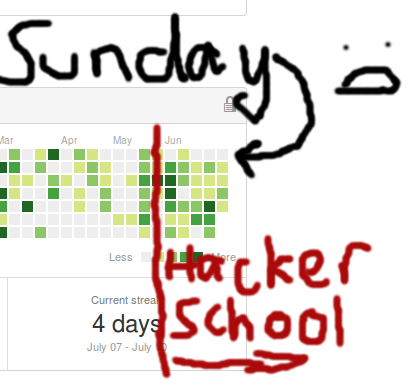Steve Klabnik gave a fantastic talk for hacker school on his transition from applications, to library, to language developer. At its core, the talk was about the different kinds of software development, and how you should explore the field and find the kind of work that fits your personality. I thought it was super interesting, and I loved his lightning-paced delivery style and witty sense of humor.
The talk would be better summarized by someone with a better memory than me, but there was one thing Steve emphasized throughout the talk one thing throughout his talk that I thought was significant: he did not want anyone to feel bad for being different from him.
I’ve found that my default response when someone I look up to talks about something they’ve done is one of distance0: they’ve done this thing that makes them different and probably better than me. Sometimes I can come up with an analog that I’ve accomplished to compare myself to them, sometimes I use this difference as a point of inspiration, as something to achieve so I can move closer to my idols, and sometimes it just makes them seem super human, and makes me seem just-regular-human in contrast. None of this is deliberate on the side of the person talking about their achievements, but these are all feelings I’ve actually felt when people I look up to talk about the awesome things that they’ve done.
Steve made a conscious effort to be inclusive in his talk. When he talked about applications programming and why he didn’t like it, he emphasized that it was just his personality that didn’t match the work. When he described the work as pulling in lots of different pieces to build something, similar to playing with legos, he emphasized that playing with legos is awesome and that this kind of work was really cool. And he repeated the same patterns when he talked about his library- and language-level work.
Steve cared so much that we didn’t feel intimidated by the field of software development that he omitted his “origin” story from the talk, and didn’t tell it until it came up in the Q&A afterwards. He had an early start with GW-BASIC during his elementary school years, but he told us that he had a distaste for “baby hacker” stories because he felt like they were irrelevant to his maturation as a programmer, and that his later years were much more significant.
I was able to talk to Steve after the Q&A about how he deliberately tried to be inclusive. He told me that he believed that programming was not a matter of genes (which is good, because we were both wearing shorts!), but one of practice. With that perspective, any sort of grandstanding doesn’t really make sense, as it drives people away who would probably make awesome programmers.
That’s something I need to internalize. I’ve given some people the impression that I know what I’m doing or that I have all my shit together. If you know me, you know that’s the furthest thing from the truth. I am living proof that someone who doesn’t have their shit together can still get things done. So if you struggle with focus, or productivity, or breaking the reddit-facebook-hacker news cycle, feel free to ping me and we can collude on actually getting things done.
I also thought it was cool that Steve has a really strong grasp on where his motivation comes from: he likes making a difference for large groups of people. I asked him what he liked about rust because I wanted to hear him nerd out about the language. His answer surprised me, though: he said that he liked the fact that it was low level, as that was something he hadn’t done since he had left college, but he seemed more excited about how rust is on an upward trend and has a real chance of displacing C++. He was super excited about how a ton of people would be affected by his work. I thought it was really cool that the future popularity of the language was such a draw to him, and that he knew enough about himself to know that that’s partially why he was drawn to the language.
As I mature, I want to explore what fuels my internal drives. It seems like something important to know about yourself.
0 Lord, I was born a rambling man.






